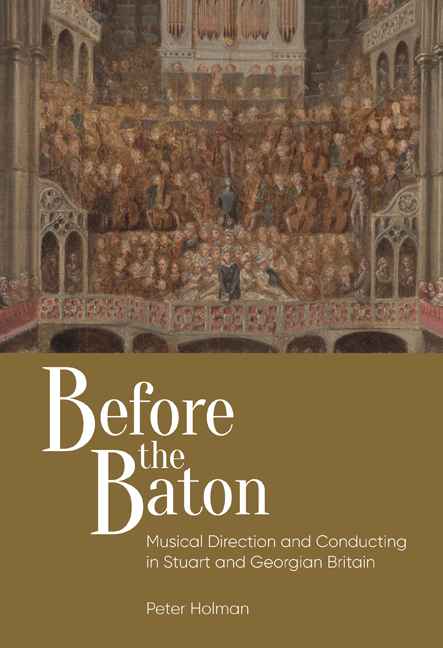Book contents
- Frontmatter
- Dedication
- Contents
- List of Illustrations
- Foreword
- Acknowledgements
- Note to the Reader
- List of Abbreviations
- Prelude To Beat or Not to Beat: The Continental Context
- Part I Directing Choral Music
- Chapter 1 ‘Heard but not Seen’: Leading Anglican Cathedral Music from the Organ
- Chapter 2 ‘With a Scroll of Parchment or Paper, in Hand’: Large- Scale Choral Music
- Chapter 3 ‘Accompanied all along on the Organ by his Own Inimitable Hand’: Handel and the Direction of his Oratorios
- Chapter 4 ‘The Conductor at the Organ’: The Oratorio Tradition after Handel
- Part II Directing Opera and Theatre Music
- Chapter 5 ‘That Ridiculous Custom’: From Devolved Direction to Centralized Time-Beating in Seventeenth-Century Theatre Music
- Chapter 6 ‘Il maestro al cembalo’: Directing Opera and Theatre Music from the Harpsichord
- Chapter 7 ‘A New Discipline and a New Style of Playing’: Directing Opera and Theatre Music from the Violin
- Chapter 8 ‘That Powerful Sovereign, the Conductor’: From the Piano to the Rostrum
- Postlude Superconductors or Semiconductors? Lessons for Today
- Bibliography
- Index
- Miscellaneous Endmatter
Chapter 2 - ‘With a Scroll of Parchment or Paper, in Hand’: Large- Scale Choral Music
Published online by Cambridge University Press: 11 September 2020
- Frontmatter
- Dedication
- Contents
- List of Illustrations
- Foreword
- Acknowledgements
- Note to the Reader
- List of Abbreviations
- Prelude To Beat or Not to Beat: The Continental Context
- Part I Directing Choral Music
- Chapter 1 ‘Heard but not Seen’: Leading Anglican Cathedral Music from the Organ
- Chapter 2 ‘With a Scroll of Parchment or Paper, in Hand’: Large- Scale Choral Music
- Chapter 3 ‘Accompanied all along on the Organ by his Own Inimitable Hand’: Handel and the Direction of his Oratorios
- Chapter 4 ‘The Conductor at the Organ’: The Oratorio Tradition after Handel
- Part II Directing Opera and Theatre Music
- Chapter 5 ‘That Ridiculous Custom’: From Devolved Direction to Centralized Time-Beating in Seventeenth-Century Theatre Music
- Chapter 6 ‘Il maestro al cembalo’: Directing Opera and Theatre Music from the Harpsichord
- Chapter 7 ‘A New Discipline and a New Style of Playing’: Directing Opera and Theatre Music from the Violin
- Chapter 8 ‘That Powerful Sovereign, the Conductor’: From the Piano to the Rostrum
- Postlude Superconductors or Semiconductors? Lessons for Today
- Bibliography
- Index
- Miscellaneous Endmatter
Summary
❧ Coronations
LEADING from the organ, the traditional method of directing Anglican cathedral choirs, seems to have sufficed for their normal activities until the twentieth century. As on the continent, time-beating became necessary when large forces were assembled for special events, and that only happened (apart from a couple of possible exceptions to be discussed in Ch. 5) after the restoration of the monarchy in 1660. It is not surprising that the first direct evidence for time-beating in England comes from the Restoration coronations in Westminster Abbey, since they were the first occasions for which large choral and orchestral groups were assembled in England, and a good deal is known about them.
The first direct evidence for time-beating comes from the coronation of James II and Mary of Modena on 23 April 1685. A list of the performers gives Francis Forcer acting as John Blow's deputy among the basses of the Chapel Royal choir and ‘in the Church also as Organist’, Blow ‘being engaged in beating time to both the Quires ([standing] by ye little organ)’. We know from Francis Sandford's commemorative book about the coronation that Blow commanded nearly 100 performers: 12 boys and 32 men from the Chapel Royal together with 8 boys and 16 men from the Abbey choir; 36 instrumentalists (in addition to the royal trumpeters who punctuated the proceedings with fanfares) were given liveries for the coronation. Sandford included a ‘GROUND-PLOT’ or diagram of the Abbey as set up for the coronation as well as plates illustrating three different stages of the ceremony. They show the Chapel Royal choir in a gallery on the south side of the altar with the specially installed organ, described as ‘A little Organ for the Kings Choir’ in Sandford's diagram. The instrumentalists were in a gallery opposite while the Abbey choir was placed further down the north side in a gallery next to the organ loft. The main organ remained in place but does not seem to have been used: Sandford described it in his key to the diagram as ‘the Great Organ and Organ Loft in which sate several spectators’, and one of the plates shows it crammed with men and women.
- Type
- Chapter
- Information
- Before the BatonMusical Direction and Conducting in Stuart and Georgian Britain, pp. 69 - 110Publisher: Boydell & BrewerPrint publication year: 2020



